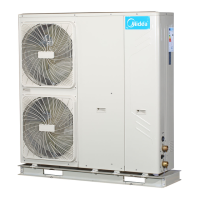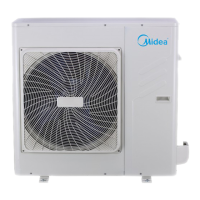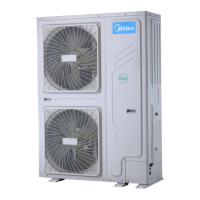NOTE
The unit is only to be used in a closed water system. Application in
an open water circuit can lead to excessive corrosion of the water
piping:
■ Never use Zn-coated parts in the water circuit. Excessive
corrosion of these parts may occur as copper piping is used in
the unit's internal water circuit.
■ When using a 3-way valve in the water circuit. Preferably
choose a ball type 3-way valve to guarantee full separation
between the domestic hot water and floor heating water circuit.
■ When using a 3-way valve or a 2-way valve in the water circuit.
The recommended maximum changeover time of the valve
should be less than 60 seconds.
NOTE
■ CounterclockWise rotation, remove the flow switch.
■ Drying the flow switch completely.
WARNING
(a) ETHYLENE GLYCOL IS TOXIC
The concentrations mentioned in the table above will not prevent
freezing, but will prevent the hydraulics from bursting.
CAUTION
Use of glycol
■ Glycol use for installations with a domestic hot water tank:
- Only propylene glycol having a toxicity rating or class of 1, as
listed in "Clinical Toxicology of Commercial Products, 5th edition"
may be used.
The maximum allowed water volume is then reduced according to
the figure “Maximum allowed water volume” on page 27.
■ If there is too much pressure when using glycol, connect the
safety valve to a drain pan to recover the glycol.
Corrosion in the system due to glycol
Uninhibited glycol will turn acidic under the influence of oxygen. This
process is accelerated by presence of copper and at higher
temperatures. The acidic uninhibited glycol attacks metal surfaces
and forms galvanic corrosion cells that cause severe damage to the
system.
It is of extreme importance:
■ That the water treatment is correctly executed by a qualified water
specialist.
■ That a glycol with corrosion inhibitors is selected to counteract
acids formed by the oxidation of glycols.
■ That in case of an installation with a domestic hot water tank, only
the use of propylene glycol is allowed. In other installations the
use of ethylene glycol is fine.
■ That no automotive glycol is used because their corrosion
inhibitors have a limited lifetime and contain silicates that can foul
or plug the system;
■ That galvanized piping is not used in glycol systems since it may
lead to the precipitation of certain elements in the glycol’s
corrosion inhibitor;
■ To ensure that the glycol is compatible with the materials used in
the system.
28
There need drying
Protecting the water circuit against freezing
Frost can cause damage to the hydraulic system. As this unit is
installed outdoors and thus the hydraulic system is exposed to
freezing temperatures, care must be taken to prevent freezing of the
system.
All hydraulic parts are insulated to reduce heat loss. Insulation must
be present on the field piping.
The unit is already equipped with several features to prevent
freezing.
■ The software contains special functions using the heat pump to
protect the entire system against freezing.
When the temperature of the water flow in the system drops to a
certain value, the unit will heat the water, either using the heat
pump, the electric heating tap, or the backup heater. The freeze
protection function will turn off only when the temperature increases
to a certain value.
In case of a power failure, the features mentioned above cannot
protect the unit from freezing.
Since a power failure could happen when the unit is unattended,
the supplier recommends adding glycol to the water system. Refer
to “Caution: Use of glycol” .
Depending on the expected lowest outdoor temperature, make sure
the water system is filled with a concentration of glycol as mentioned
in the table below.
Water may enter into the flow switch and cannot be drained out and
may freeze when the temperature is low enough. The flow switch
should be removed and dried, then can be reinstalled in the unit.
When glycol is added to the system, the performance of the unit will
be affected. The correction factor of the unit capacity, flow rate and
pressure drop of the system is listed in the table below
If no glycol is added, the water must be drained out when there is a
power failure.
Ethylene Glycol
Propylene Glycol
Cooling capacity
modification
Power
modification
Water
resistanc
Water flow
modification
0 1.000 1.000 1.000 1.000 0.000
10 0.984 0.998 1.118 1.019 -4.000
20 0.973 0.995 1.268 1.051 -9.000
30 0.965 0.992 1.482 1.092 -16.000
40 0.960 0.989 1.791 1.145 -23.000
50 0.950 0.983 2.100 1.200 -37.000
0 1.000 1.000 1.000 1.000 0.000
10 0.976 0.996 1.071 1.000 -3.000
20 0.961 0.992 1.189 1.016 -7.000
30 0.948 0.988 1.380 1.034 -13.000
40 0.938 0.984 1.728 1.078 -22.000
50 0.925 0.975 2.150 1.125 -35.000
Modification coefficient
Quality of
glycol/%
Freezing
point/℃
Modification coefficient
Cooling capacity
modification
Power
modification
Water
resistanc
Water flow
modification
Quality of
glycol/%
Freezing
point/℃

